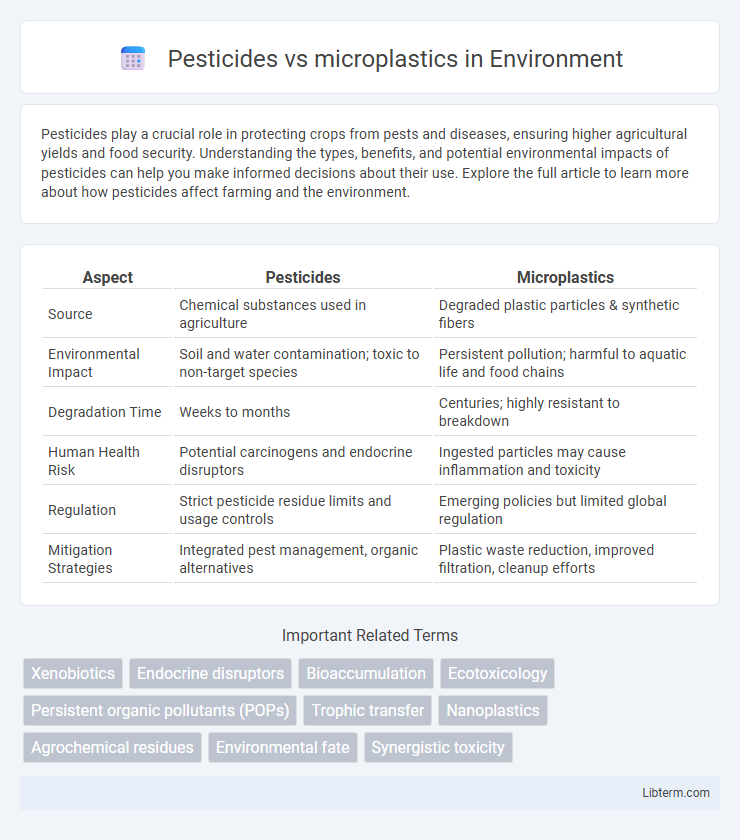Pesticides play a crucial role in protecting crops from pests and diseases, ensuring higher agricultural yields and food security. Understanding the types, benefits, and potential environmental impacts of pesticides can help you make informed decisions about their use. Explore the full article to learn more about how pesticides affect farming and the environment.
Table of Comparison
| Aspect | Pesticides | Microplastics |
|---|---|---|
| Source | Chemical substances used in agriculture | Degraded plastic particles & synthetic fibers |
| Environmental Impact | Soil and water contamination; toxic to non-target species | Persistent pollution; harmful to aquatic life and food chains |
| Degradation Time | Weeks to months | Centuries; highly resistant to breakdown |
| Human Health Risk | Potential carcinogens and endocrine disruptors | Ingested particles may cause inflammation and toxicity |
| Regulation | Strict pesticide residue limits and usage controls | Emerging policies but limited global regulation |
| Mitigation Strategies | Integrated pest management, organic alternatives | Plastic waste reduction, improved filtration, cleanup efforts |
Introduction to Pesticides and Microplastics
Pesticides are chemical substances used in agriculture to control pests, diseases, and weeds, enhancing crop yield and food security. Microplastics, tiny plastic particles less than 5mm in size, originate from the breakdown of larger plastic debris or from microbeads in consumer products, posing significant environmental hazards. Both pesticides and microplastics persist in ecosystems, leading to bioaccumulation and adverse effects on wildlife and human health.
Definitions and Key Differences
Pesticides are chemical substances used to eliminate or control pests in agriculture, while microplastics are tiny plastic particles less than 5mm in size resulting from the breakdown of larger plastic debris. Pesticides primarily affect biological organisms by disrupting pest populations, whereas microplastics pose physical and chemical hazards to marine and terrestrial ecosystems through ingestion and contamination. The key difference lies in their origin--pesticides being synthetic chemicals intentionally applied for pest control, and microplastics being unintended environmental pollutants from plastic degradation.
Sources and Pathways into the Environment
Pesticides enter the environment primarily through agricultural runoff, spray drift, and improper disposal, contaminating soil, water, and air. Microplastics originate from the breakdown of larger plastic debris, synthetic fibers from textiles, and microbeads in personal care products, which infiltrate aquatic and terrestrial ecosystems via wastewater discharge and atmospheric deposition. Both contaminants travel through interconnected pathways, including surface water flow, soil leaching, and atmospheric transport, posing significant risks to environmental health and biodiversity.
Environmental Fate and Persistence
Pesticides often degrade through chemical reactions and microbial activity, with half-lives ranging from days to months, leading to variable environmental persistence depending on compound type and conditions. Microplastics exhibit extreme persistence, resisting biodegradation for decades to centuries due to their polymer structure and environmental stability. Both contaminants pose long-term ecological risks, but microplastics accumulate in soils, sediments, and aquatic systems, while pesticides may transform into metabolites with differing toxicity and mobility profiles.
Impacts on Human Health
Pesticides, such as organophosphates and neonicotinoids, disrupt endocrine function and increase risks of neurological disorders and cancers through chronic exposure. Microplastics, prevalent in food and water sources, trigger inflammatory responses and may carry toxic chemicals or pathogens that exacerbate respiratory and gastrointestinal diseases. Both contaminants pose cumulative health risks, with pesticides directly affecting biochemical pathways, while microplastics induce physical and chemical stresses at cellular levels.
Effects on Wildlife and Ecosystems
Pesticides disrupt wildlife by contaminating habitats, causing reproductive failures, behavioral changes, and mortality in insects, birds, and aquatic species. Microplastics infiltrate ecosystems through ingestion, leading to physical blockages, toxic chemical accumulation, and impaired growth in marine and terrestrial organisms. Both pollutants degrade biodiversity and ecosystem functions, threatening food webs, nutrient cycles, and overall environmental health.
Regulations and Control Measures
Regulations on pesticides strictly limit residue levels to protect ecosystems and human health, with agencies like the EPA enforcing registration and usage guidelines. In contrast, microplastics face emerging regulatory frameworks focusing on source reduction, wastewater treatment improvements, and bans on microbeads in personal care products. Effective control measures for both include monitoring environmental levels, promoting sustainable practices, and strengthening international cooperation to minimize contamination.
Detection and Monitoring Methods
Detection and monitoring methods for pesticides commonly rely on chromatographic techniques such as gas chromatography-mass spectrometry (GC-MS) and liquid chromatography-tandem mass spectrometry (LC-MS/MS) to identify and quantify chemical residues in soil, water, and food samples. Microplastics detection involves spectroscopic methods including Fourier-transform infrared spectroscopy (FTIR) and Raman spectroscopy, which enable the identification of polymer types and particle sizes in environmental matrices. Emerging sensor technologies and automated imaging software enhance real-time monitoring accuracy for both pesticides and microplastics, facilitating comprehensive environmental assessments and regulatory compliance.
Solutions and Sustainable Alternatives
Biodegradable pesticides derived from natural compounds offer effective pest control without soil and water contamination typically caused by conventional chemicals, reducing microplastic accumulation in ecosystems. Implementing integrated pest management (IPM) strategies minimizes pesticide use by combining biological controls, crop rotation, and resistant crop varieties, promoting long-term agricultural sustainability. Advances in bioplastics and natural fiber-based packaging provide sustainable alternatives to microplastic pollutants, mitigating environmental hazards and supporting circular economy principles.
Future Challenges and Research Directions
Future challenges in addressing pesticides and microplastics include understanding their combined effects on ecosystems and human health, as well as developing efficient detection and removal technologies. Research directions emphasize the need for advanced analytical methods to monitor low-concentration pollutants and the development of sustainable agrochemicals and biodegradable materials to mitigate environmental impact. Interdisciplinary studies integrating toxicology, environmental science, and materials engineering are critical for creating effective policies and remediation strategies.
Pesticides Infographic

 libterm.com
libterm.com